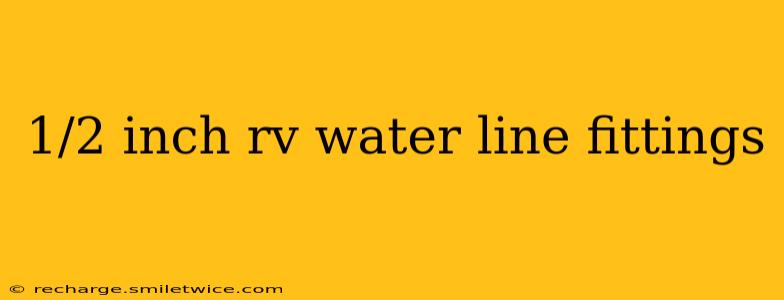Finding the right fittings for your RV's water lines is crucial for a safe and enjoyable camping experience. A leak can quickly ruin a trip, so understanding the different types of 1/2 inch RV water line fittings and how to choose the best ones is essential. This guide will cover everything you need to know, answering common questions and providing expert advice.
What Types of 1/2 Inch RV Water Line Fittings Are Available?
Several types of 1/2 inch RV water line fittings are available, each designed for specific purposes and situations. The most common include:
-
Push-to-Connect Fittings: These are incredibly popular for their ease of use. Simply push the tubing into the fitting, and you're done. No clamps or special tools are needed, making them ideal for quick repairs or installations. However, it's crucial to ensure a good, secure connection; otherwise, leaks can occur.
-
Compression Fittings: These fittings use a compression ring to create a watertight seal around the tubing. They are generally more robust and reliable than push-to-connect fittings, offering a stronger, more secure connection, especially under pressure. They require a wrench or pliers for installation.
-
Barb Fittings: These fittings have a barbed interior that grips the tubing. Clamps are usually necessary to secure the connection completely and prevent leaks. While less expensive, they can be tricky to install correctly and are prone to leaks if not done properly.
-
John Guest Fittings (JG): These are a type of push-to-connect fitting known for their high quality and reliability. They often offer a more secure connection than other push-to-connect options.
What Materials Are 1/2 Inch RV Water Line Fittings Made Of?
The material of your fittings is just as important as the type. Common materials include:
-
Brass: Brass fittings are durable, corrosion-resistant, and offer excellent longevity. They are generally more expensive than plastic but offer superior performance and reliability in the long run.
-
Plastic (typically PVC or CPVC): Plastic fittings are lightweight, affordable, and easy to work with. However, they're not as durable as brass and can be more prone to cracking or damage from extreme temperatures or pressure.
How Do I Choose the Right 1/2 Inch RV Water Line Fittings?
Choosing the right fittings depends on several factors:
-
Your RV's Water System: Understanding your current setup is key. If your RV uses push-to-connect fittings, it's generally best to stick with the same type for consistency and ease of repair.
-
Your Budget: Brass fittings are more expensive but offer superior durability. Plastic fittings are a more budget-friendly option, but they might require more frequent replacements.
-
Your Skill Level: Push-to-connect fittings are the easiest to install, while compression and barb fittings require more skill and tools.
-
The Application: Consider the specific use case. For critical connections, like those near the water pump, more robust fittings are recommended.
What Size Tubing Do I Need for 1/2 Inch RV Water Line Fittings?
While the fitting is 1/2 inch, the tubing's outer diameter might slightly vary depending on the type of tubing (e.g., polyethylene, PEX). It's crucial to check the specifications of your chosen tubing and ensure it's compatible with the fittings you purchase. Consult the manufacturer's instructions for both the fittings and the tubing to confirm compatibility.
Are There Any Special Considerations for Using 1/2 Inch RV Water Line Fittings?
-
Proper Installation: Always follow the manufacturer's instructions carefully for proper installation. A poorly installed fitting can lead to leaks or even damage to your RV's water system.
-
Regular Inspection: Regularly inspect your water lines and fittings for leaks, cracks, or damage. Address any issues promptly to prevent more significant problems.
-
Winterizing: Properly winterize your RV's water system to prevent damage from freezing temperatures.
By understanding the different types of 1/2 inch RV water line fittings and their characteristics, you can make informed decisions to ensure a reliable and trouble-free water system in your RV, allowing you to enjoy your camping adventures without worry. Remember to always prioritize safety and choose fittings that meet your needs and skill level.
